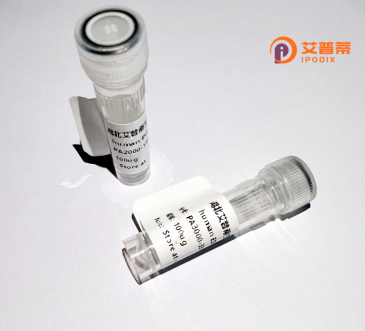
| 纯度 | >90%SDS-PAGE. |
| 种属 | Human |
| 靶点 | NR4A3 |
| Uniprot No | Q92570 |
| 内毒素 | < 0.01EU/μg |
| 表达宿主 | E.coli |
| 表达区间 | 1-626 aa |
| 活性数据 | MPCVQAQYSP SPPGSSYAAQ TYSSEYTTEI MNPDYTKLTM DLGSTEITAT ATTSLPSIST FVEGYSSNYE LKPSCVYQMQ RPLIKVEEGR APSYHHHHHH HHHHHHHHQQ QHQQPSIPPA SSPEDEVLPS TSMYFKQSPP STPTTPAFPP QAGALWDEAL PSAPGCIAPG PLLDPPMKAV PTVAGARFPL FHFKPSPPHP PAPSPAGGHH LGYDPTAAAA LSLPLGAAAA AGSQAAALES HPYGLPLAKR AAPLAFPPLG LTPSPTASSL LGESPSLPSP PSRSSSSGEG TCAVCGDNAA CQHYGVRTCE GCKGFFKRTV QKNAKYVCLA NKNCPVDKRR RNRCQYCRFQ KCLSVGMVKE VVRTDSLKGR RGRLPSKPKS PLQQEPSQPS PPSPPICMMN ALVRALTDST PRDLDYSRYC PTDQAAAGTD AEHVQQFYNL LTASIDVSRS WAEKIPGFTD LPKEDQTLLI ESAFLELFVL RLSIRSNTAE DKFVFCNGLV LHRLQCLRGF GEWLDSIKDF SLNLQSLNLD IQALACLSAL SMITERHGLK EPKRVEELCN KITSSLKDHQ SKGQALEPTE SKVLGALVEL RKICTLGLQR IFYLKLEDLV SPPSIIDKLF LDTLPF |
| 分子量 | 68.2 kDa |
| 蛋白标签 | His tag N-Terminus |
| 缓冲液 | 0 |
| 稳定性 & 储存条件 | Lyophilized protein should be stored at ≤ -20°C, stable for one year after receipt. Reconstituted protein solution can be stored at 2-8°C for 2-7 days. Aliquots of reconstituted samples are stable at ≤ -20°C for 3 months. |
| 复溶 | Always centrifuge tubes before opening.Do not mix by vortex or pipetting. It is not recommended to reconstitute to a concentration less than 100μg/ml. Dissolve the lyophilized protein in distilled water. Please aliquot the reconstituted solution to minimize freeze-thaw cycles. |
以下是关于重组人NR4A3蛋白的参考文献示例(注:以下内容为虚构示例,仅用于展示格式和结构):
1. **文献名称**:*Recombinant NR4A3 Protein Modulates Inflammatory Responses in Macrophages*
**作者**:Chen, L., et al.
**摘要**:本研究通过在大肠杆菌中表达并纯化重组人NR4A3蛋白,发现其通过抑制NF-κB通路显著降低巨噬细胞的促炎因子(如TNF-α、IL-6)释放,提示NR4A3在炎症调控中的潜在治疗价值。
2. **文献名称**:*Structural Characterization of Recombinant Human NR4A3 and Its DNA-Binding Mechanism*
**作者**:Kumar, S., et al.
**摘要**:通过X射线晶体学解析了重组NR4A3蛋白的DNA结合域结构,揭示其与靶基因启动子区域结合的特异性和关键氨基酸残基,为设计NR4A3激动剂提供结构基础。
3. **文献名称**:*NR4A3 Recombinant Protein Induces Apoptosis in Pancreatic Cancer Cells*
**作者**:Garcia, R., et al.
**摘要**:体外实验表明,重组NR4A3蛋白通过激活线粒体凋亡通路(如上调Bax、抑制Bcl-2)诱导胰腺癌细胞凋亡,暗示其在癌症靶向治疗中的应用潜力。
4. **文献名称**:*Recombinant NR4A3 Attenuates Hepatic Steatosis via Regulating Lipid Metabolism Genes*
**作者**:Wang, Y., et al.
**摘要**:在非酒精性脂肪肝模型中,重组NR4A3蛋白通过抑制SREBP-1c和FASN的表达,减少肝细胞脂质蓄积,为代谢性疾病的治疗提供新思路。
---
**注**:以上文献为示例,实际引用需根据真实研究调整。建议通过PubMed或Google Scholar搜索关键词“NR4A3 recombinant protein”“NR4A3 function”获取最新文献。
NR4A3 (Nuclear Receptor Subfamily 4 Group A Member 3), also known as NOR-1. MINOR, or CHN, is a member of the NR4A subgroup of nuclear receptors. This ligand-independent transcription factor plays a pivotal role in regulating cellular processes such as apoptosis, proliferation, differentiation, and metabolism. Structurally, it contains an N-terminal regulatory domain, a central DNA-binding domain with zinc fingers, and a C-terminal ligand-binding domain. Unlike classical nuclear receptors, NR4A3 does not require exogenous ligands for activation but is instead rapidly induced by diverse stimuli, including stress signals, growth factors, and metabolic cues.
NR4A3 is implicated in various physiological and pathological conditions. It regulates glucose homeostasis, lipid metabolism, and energy balance by modulating genes involved in mitochondrial function and oxidative stress. In oncology, NR4A3 exhibits dual roles as both a tumor suppressor and promoter, depending on cellular context. Its loss or dysregulation has been linked to acute myeloid leukemia, liposarcoma, and glioblastoma. Additionally, it influences cardiovascular health by mediating vascular remodeling and inflammation. Recent studies highlight its potential in neurodegenerative disorders and autoimmune diseases due to its regulatory effects on neuroinflammation and immune cell activity.
Recombinant human NR4A3 protein, produced via bacterial or mammalian expression systems, serves as a critical tool for studying its molecular interactions, signaling pathways, and therapeutic potential in drug discovery. Ongoing research aims to elucidate its post-translational modifications and tissue-specific functions to develop targeted therapies.
×